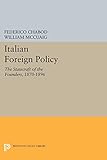Italian Foreign Policy : The Statecraft of the Founders, 1870-1896 / Federico Chabod.
Material type: TextSeries: Agnelli ; 323Publisher: Princeton, NJ : Princeton University Press, [2014]Copyright date: ©1996Edition: Course BookDescription: 1 online resource (644 p.)Content type:
TextSeries: Agnelli ; 323Publisher: Princeton, NJ : Princeton University Press, [2014]Copyright date: ©1996Edition: Course BookDescription: 1 online resource (644 p.)Content type: - 9780691606170
- 9781400864225
- 327.45
- DG564
- online - DeGruyter
- Issued also in print.
| Item type | Current library | Call number | URL | Status | Notes | Barcode | |
|---|---|---|---|---|---|---|---|
 eBook
eBook
|
Biblioteca "Angelicum" Pont. Univ. S.Tommaso d'Aquino Nuvola online | online - DeGruyter (Browse shelf(Opens below)) | Online access | Not for loan (Accesso limitato) | Accesso per gli utenti autorizzati / Access for authorized users | (dgr)9781400864225 |
Browsing Biblioteca "Angelicum" Pont. Univ. S.Tommaso d'Aquino shelves, Shelving location: Nuvola online Close shelf browser (Hides shelf browser)

|

|

|

|

|

|

|
||
| online - DeGruyter The Economies of Central Asia / | online - DeGruyter The Galitzin Quartets of Beethoven : Opp. 127, 132, 130 / | online - DeGruyter From the Outside In : World War II and the American State / | online - DeGruyter Italian Foreign Policy : The Statecraft of the Founders, 1870-1896 / | online - DeGruyter The Collected Letters of William Morris, Volume III : 1889-1892 / | online - DeGruyter The Collected Letters of William Morris, Volume IV : 1893-1896 / | online - DeGruyter Suburbs under Siege : Race, Space, and Audacious Judges / |
Frontmatter -- CONTENTS -- FOREWORD TO THE SERIES -- FEDERICO CHABOD: A BIO-BIBLIOGRAPHICAL PROFILE BY FRANCESCO TUCCARI -- FEDERICO CHABOD, HISTORIAN OF ITAUAN FOREIGN POLICY BY WALTER MATURI -- PREFACE -- A NOTE ON SOURCES AND ABBREVIATIONS -- TRANSLATOR'S NOTE -- PART ONE: PASSIONS AND IDEAS -- I. The Franco-Prussian War and Italy -- CHAPTER 1. What Prussia Had to Teach -- CHAPTER 2. The Lesson of "Reality" in France -- CHAPTER 3. Against the "Realism" of Bismarck -- II. The Idea of Rome -- CHAPTER 4. The "Mission" of Rome -- CHAPTER 5. Science or Renovatio Ecclesiae -- CHAPTER 6. The Shadow of Caesar -- CHAPTER 7. The Anti-Romans -- III. Order and Liberty -- CHAPTER 8. The Conservative Program -- CHAPTER 9. Among the Elite -- CHAPTER 10. Liberty and Law -- IV. The Present and the Future -- CHAPTER 11. The Present and the Future -- PART TWO: THE OBJECTIVE WORLD AND THE WORLD OF MEN -- I. The Objective World -- CHAPTER 12. Finance and the Army -- CHAPTER 13. Political Apathy -- CHAPTER 14. High Politics or the Politics of Tranquillity? -- II. The World of Men -- CHAPTER 15. Emilio Visconti Venosta -- CHAPTER 16. Costantino Nigra -- CHAPTER 17. Count de Launay -- CHAPTER 18. Count di Robilant -- CHAPTER 19. Lanza and Minghetti -- CHAPTER 20. Vittorio Emanuele II -- BIBLIOGRAPHY -- INDEX
restricted access online access with authorization star
http://purl.org/coar/access_right/c_16ec
Federico Chabod (1901-1960) was one of Italy's best-known historians, noted for his study of Italian history in a European context. This is the first English translation of his most important book. Although he carried out his extensive archival research for this work from 1936 until 1943, the fall of fascism and Chabod's active participation in the Resistance delayed its completion. When it was published in 1951, it was immediately hailed as a masterpiece.Chabod intended to write a new kind of diplomatic history-- one in which political history is seen as part of a larger historical whole. He does not present a detailed chronological account of Italian foreign policy during the period studied, but rather the "moral and material" underpinnings of that policy. In fact, he crafts a highly developed portrait of an age, with the real subjects being the Italian state and society, the ruling class and political culture. This work offers readers a superb picture of post-Risorgimento Italy and an outstanding example of Chabod's historiographical method.Originally published in 1996.The Princeton Legacy Library uses the latest print-on-demand technology to again make available previously out-of-print books from the distinguished backlist of Princeton University Press. These editions preserve the original texts of these important books while presenting them in durable paperback and hardcover editions. The goal of the Princeton Legacy Library is to vastly increase access to the rich scholarly heritage found in the thousands of books published by Princeton University Press since its founding in 1905.
Issued also in print.
Mode of access: Internet via World Wide Web.
In English.
Description based on online resource; title from PDF title page (publisher's Web site, viewed 30. Aug 2021)


